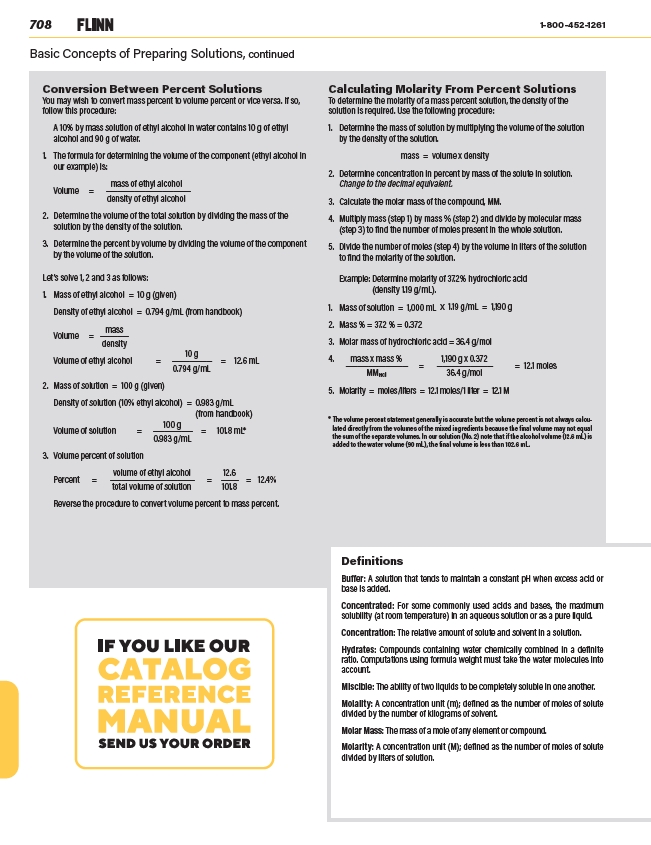
708 1-800-452-1261
Basic Concepts of Preparing Solutions, continued
Conversion Between Percent Solutions
You may wish to convert mass percent to volume percent or vice versa. If so,
follow this procedure:
A 10% by mass solution of ethyl alcohol in water contains 10 g of ethyl
alcohol and 90 g of water.
1. The formula for determining the volume of the component (ethyl alcohol in
our example) is:
mass of ethyl alcohol
Volume = ———————————————
density of ethyl alcohol
2. Determine the volume of the total solution by dividing the mass of the
solution by the density of the solution.
3. Determine the percent by volume by dividing the volume of the component
by the volume of the solution.
Let’s solve 1, 2 and 3 as follows:
1. Mass of ethyl alcohol = 10 g (given)
Density of ethyl alcohol = 0.794 g/mL (from handbook)
mass
Volume = —————
density
10 g
Volume of ethyl alcohol = ——————— = 12.6 mL
0.794 g/mL
2. Mass of solution = 100 g (given)
Density of solution (10% ethyl alcohol) = 0.983 g/mL
(from handbook)
100 g
Volume of solution = ——————— = 101.8 mL*
0.983 g/mL
3. Volume percent of solution
volume of ethyl alcohol 12.6
Percent = ——————————————— = ——— = 12.4%
total volume of solution 101.8
Reverse the procedure to convert volume percent to mass percent.
Calculating Molarity From Percent Solutions
To determine the molarity of a mass percent solution, the density of the
solution is required. Use the following procedure:
1. Determine the mass of solution by multiplying the volume of the solution
by the density of the solution.
mass = volume x density
2. Determine concentration in percent by mass of the solute in solution.
Change to the decimal equivalent.
3. Calculate the molar mass of the compound, MM.
4. Multiply mass (step 1) by mass % (step 2) and divide by molecular mass
(step 3) to find the number of moles present in the whole solution.
5. Divide the number of moles (step 4) by the volume in liters of the solution
to find the molarity of the solution.
Example: Determine molarity of 37.2% hydrochloric acid
(density 1.19 g/mL).
1. Mass of solution = 1,000 mL x 1.19 g/mL = 1,190 g
2. Mass % = 37.2 % = 0.372
3. Molar mass of hydrochloric acid = 36.4 g/mol
4. mass x mass % 1,190 g x 0.372
——————————— = —————————— = 12.1 moles
MMHCl 36.4 g/mol
5. Molarity = moles/liters = 12.1 moles/1 liter = 12.1 M
* The volume percent statement generally is accurate but the volume percent is not always calculated
directly from the volumes of the mixed ingredients because the final volume may not equal
the sum of the separate volumes. In our solution (No. 2) note that if the alcohol volume (12.6 mL) is
added to the water volume (90 mL), the final volume is less than 102.6 mL.
Definitions
Buffer: A solution that tends to maintain a constant pH when excess acid or
base is added.
Concentrated: For some commonly used acids and bases, the maximum
solubility (at room temperature) in an aqueous solution or as a pure liquid.
Concentration: The relative amount of solute and solvent in a solution.
Hydrates: Compounds containing water chemically combined in a definite
ratio. Computations using formula weight must take the water molecules into
account.
Miscible: The ability of two liquids to be completely soluble in one another.
Molality: A concentration unit (m); defined as the number of moles of solute
divided by the number of kilograms of solvent.
Molar Mass: The mass of a mole of any element or compound.
Molarity: A concentration unit (M); defined as the number of moles of solute
divided by liters of solution.